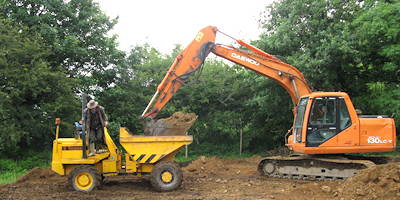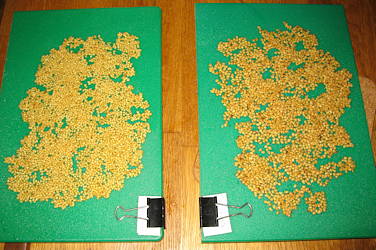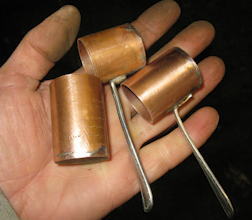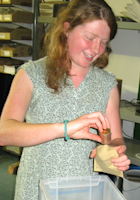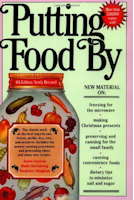The Real Seed Catalogue
Summer 2012 Garden Report
Welcome readers old and new, to our annual report back to you with news about our trials, new crops for this year, and other things that we've been doing here at Real Seeds. For those of you new to us - this is your chance to see 'behind the scenes' and get a glimpse of what happens to get all those seeds in to their packets.
Every year lots of people want to come and visit and meet us, and see our seed gardens, but sadly we just don't have time or resources to run open days. Instead we try to document everything we do throughout the year and publish it here for you all to read about. We hope you enjoy it.
Ben & Kate, Newport , July 2012
If you have any comments or suggestions, its always nice to hear from you
and you can drop us an email to ![]() (include your postcode so we know where in the country you are)
(include your postcode so we know where in the country you are)
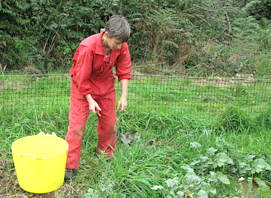 Kate harvesting roots |
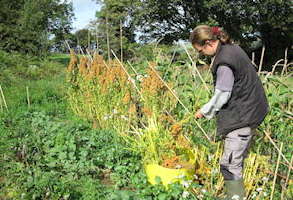 Ben harvesting grains |
 The greenhouse Slug Control staff |
A tricky year for growers everywhere
Here in west Wales, we've had a rather erratic season so far - lovely and warm in March, so wet in April that we couldn't get on the land, then a mini-heatwave in May, the wettest June in Wales since records began, and now as we write in early July yet more rain on its way.
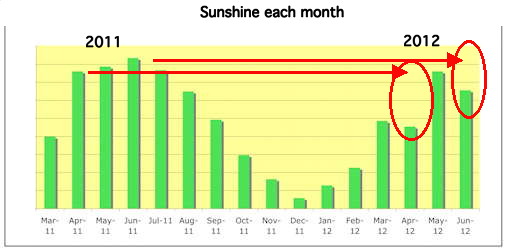 |
You can see why things aren't growing so well this season. This April and June were missing about 1/3 of their sunshine compared to last year! (Data from our solar power system)
|
However, we did manage to get things in the ground in a couple of the dry spells, and quite a few crops here at Real Seeds are growing surprisingly well given the lack of sunshine.
If you're having a difficult (or disastrous) season, don't be too disheartened, though - it's not just you. We, and everyone we know, have really found it trying this year, with slow germination, slugs, damping off and plants just not growing. After all, plants rely on sunshine for their energy, and with no sun, they are inevitably going to struggle. Let's hope for a long sunny spell for the rest of the summer and autumn!
Seedsaving keeps increasing in popularity . . .
Many of you are keeping your own seed these days using our free instructions. This is great, it is what we want to see - home gardeners keeping and adapting their own strains to their own local conditions. It is an important part of taking control back over your own life, and having food security through developing locally-adapted strains of your favourite vegetable varieties.
| "Hi, I think it must have been 2007 when I bought some seeds from you. I went for the Cherokee Trail of Tears french bean, the Hatif D'Annonay and Telephone peas. Since then I have always been able to save enough of these varieties to keep me going year on year and they never disappoint on flavour or germination. I've moved on to saving my runner beans and vetch varieties as well as my calendula, coreopsis and dahlias. The calendula just get broadcast onto the ground and they germinate and grow without any help from me. They also keep the weeds down!. I came across your small advert all those years ago and I'm so pleased I did. Thank you for being there." - Peter Butler |
Remember though, all of our varieties are ok to save seed from, but you can't save seed from F1 hybrids. There are detailed open-source instructions for seedsaving on the left under the 'Seedsaving' box. Why not give it a go?
If you save your own seed, email us a pic of you with your saved seed! We're going to add a SeedSavers Gallery to the website.
. . . and we will have lots of new things in the Catalogue.
People saving their own seed is not a problem for us as there are always so many other exciting varieties we want grow and offer to you as well. So we always are on the lookout for new things to go in the catalogue, and this year we have some really special new additions.
There are many things we are hoping for, but these are the ones that look promising as we write:
- Pink Passion Chard (an incredible pink stem)
- Red Sun Sunflower (finally, after 8 years!)
- Lord Leicester Pea (from our ongoing pea rescue project)
- Viroflex winter spinach (an improved strain of well-known Viroflay)
- Several great new strains of our ever-popular Oca tubers
- A particularly exciting new sweetcorn - the first new non-hybrid early corn bred in Europe for many years.
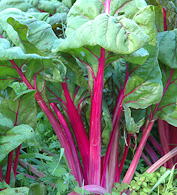 Our new Pink Passion Chard |
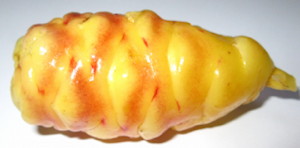 Our new Bicolour Oca (grown and used like potatoes) |
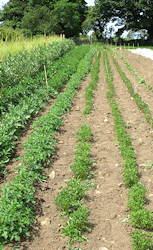 (L to R) Potatoes, Oca and Yacon, all growing together as they were 1000 years ago in South America. |
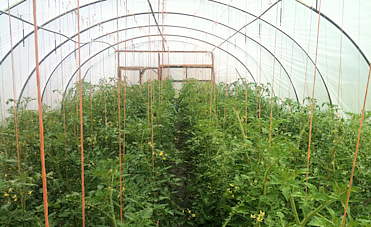 A tunnel of our tomatoes at Ian Hearn's holding |
We also have several farmers growing for us this season, so from Ian Hearn, Melissa Stephens, Tony Haigh and Jen Boncyk, who are producing much of our tomato seed for us, we will get some exciting new varieties for you to grow:
- Chadwick Cherry (commercially extinct, until now that is)
- Jen's Tangerine
- Ethel Watkins' Best
- Orange Banana
- Mucho Miel (name means 'lots of honey')
- Gardeners' Ecstacy (like Gardeners' Delight but better)
- PeaceVine
- Oregon Spring (very early, first ripe one July 5th this year)
As well of course as all the old favourites like Latah (we can never grow enough of it!), Grushovka , Urbikany, and Dr Carolyn.
Work on the Land in 2012
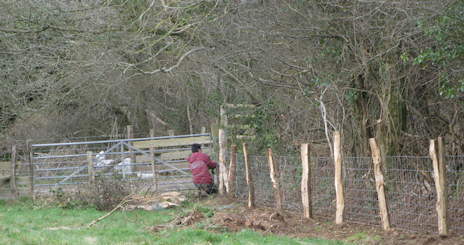 Ian restoring an old hedgebank, and putting up new fence, Feb 2012 Posts are hand-cleft local oak, and should last a lifetime. |
We spent much of the winter months improving our land - those of you who have read previous newsletters will know that our fields were just neglected grazing when we got them.
We started out by planting 2000 trees in January, restored the hedges, replaced our sheep fencing, and put up almost a kilometer of rabbit fencing, to stop the rabbits eating the trees. So at times it was hard work.
But there were lots of fun little things happening too - we got huge crops off our beds for growing Parasol mushrooms on spoilt hay (this is great as we get to eat the mushrooms and the hay becomes potting compost), and we finished off the installation of our borehole, although it wasn't really needed this spring given all the rain!
Although most are well established now, a few of the fruit trees that we planted last year had failed, and we replaced them with new trees that we grafted ourselves using cuttings from the most vigorous ones.
Finally, we planted hundreds of spring flowers and bulbs along the edge of the track. Our fruit-bushes have started to crop, and we were hosts to a family of pheasants living in our hedgerow, much to the amusement of our dog Basil (he's too old to catch them but likes watching).
Other wildlife that we have in our fields include at least one grass snake, an entire extended family of voles, plenty of toads - but hopefully no more rabbits!
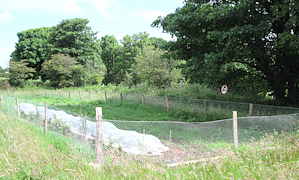 The new isolation garden
The new isolation garden
We have two separate plots of land about a mile apart, each being 3 acres or so. We're very excited about a new little isolation garden that we've created up on our further-away 'mountain fields'.
There always seems to be just one more thing that we want to fit into the main field but can't because it will cross with a variety that we've already scheduled to grow that year.
At the moment, our new plot is pretty rough, with just a bit of field rotavated and rabbit fenced, but we've already got an extra crop of beetroot and a new trial variety of squash growing away there.
Although the mountain fields are quite high and sloping, the isolation garden is in quite a sheltered spot in the bottom corner, so once the ground is improved it should let us grow more varieties of lots of crops. There's room at the other end of the site for another isolation plot too, and we hope to have that in use by 2015.
And lots (and lots) of trees
Apart from the isolation garden, the mountain fields are going to be our source of wood for heating, fenceposts, and beanpoles. This winter, we planted around 2000 trees there (in 3 days!) with Ian and Paul's help, plus another 3 days protecting them with mulch mats and vole/rabbit guards.
The trees are a mixture of native deciduous species - lots of ash, hazel, alder and smaller numbers of lots of other species including oak, holly, and lime - here in January 2012 you can see Josie in the field with each tree surrounded by its weed-suppressing mat:
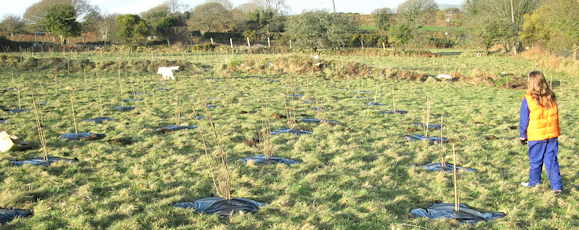
Even after just a few months, the fields are looking quite different already, helped of course by the very rainy and wet summer we've had so far.
Back on our main site, the fruit and nut trees we planted the winter before last are starting to look well established, and we even have three almonds on one little tree. We have limed heavily and planted more green manures on the parts that are lying fallow, so when we come to sow seed crops on them the soil will be in good heart.
 Our sturdy little tractor and growing machinery need protection from the rain |
Barn and polytunnels
In last year's newsletter you'll remember we were busy putting together plans for a barn to house our machinery safely and allow us to dry larger quantities of seed, plus two polytunnels for growing things like tomato and pepper seed.
The really big change since then is that at long last (it took over 18 months!) we were granted planning permission for this.
The other good news is that we have now raised the funds for building them - many thanks to everyone who ordered from us over the last three years as it is you who have made this possible.
We hope our new buildings will allow us to supply you with more, and better, seed for many years to come!
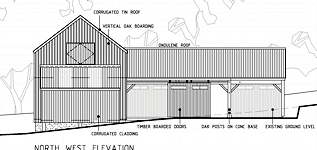 Plans for the new Seed-drying Barn |
 |
So, that just leaves the small matter of having to actually build them. Recently we've started to prepare the site - because our fields are quite sloping, we need to make flat terraces for the barn and tunnel to sit on. We've cleared and rotavated these areas, and this week we've had the digger in to flatten the spot for the barn, and use the removed materials to build up a level platform for the polytunnels to sit on.
|
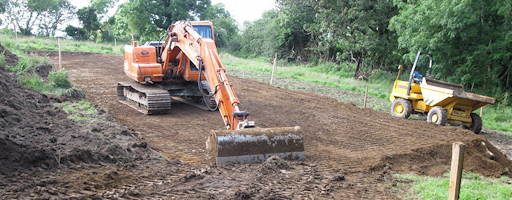 . . . and making a terrace for the polytunnels, July 2012 |
We're hoping to get the polytunnels up this autumn, so that we can sow overwintering crops ready to flower & set seed next summer,
and then start building the barn in 2013. We'll let you know how it is going in the next newsletter.
Seed packing technology
If you ever wonder how exactly we get all the seeds into the packets (and we do too sometimes, in truth!), the answer is by hand. Like all seed houses, we have a range of carefully-measured little scoops and every variety gets a different sized scoopful put into its envelope. It is actually incredibly accurate (to 0.1 of a gram for small seed) as long as you have the right scoop figured out in advance. (The computer keeps track of which one goes with each variety.)
|
Some really precious things like tomatoes, peppers and squash are actually counted out, to make sure you get the right number.
It's quite a big operation, filling hundreds of thousands of packets each year - three people work for us year round filling the packets and next time you open an envelope you should think of Kate S, Anja and Heather!
But we have changed things a bit this year: Firstly, after counting out 123,252 (!) individual tomato seeds, Kate S has decided (quite reasonably) that she couldn't face it any more.
So over the next season, we will start getting the more-popular tomatoes counted by machine into small foil packets. You'll find these in some of the new envelopes, but don't be worried by the very modern look of them, its our same special seed inside.
Secondly, Ben has slowly been upgrading our seed scoops to nice new copper and brass ones, to replace the old scoops made of plastic pipe. In the pictures below you can see the process from start to finish. (The design is quite important as there is a certain ratio of width to height that keeps them accurate - so every packet gets the same amount of seed.)
Making the new scoops is slow but they are very pleasing once all polished up - shiny copper with brass bottoms, and antique silver spoon handles. If people are going to do a boring repetitive job, then we think it important that they have nice tools to work with.
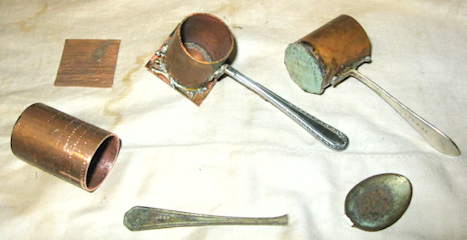 Stages in making a seed scoop: copper pipe cut to size, a bottom and handle are soldered on |
... then filed smooth and polished... |
...and used by Heather |
Finally, with a view to the future, we've been looking again at the wonderful Ballard seed packing machines, 130 years old now but still really reliable. They take a size of seed envelope that's not made here any more, so we've been working with a paper company to make some special envelopes of the old size, and try them out on a restored machine in USA. The first lot worked, but not perfectly, so we'll continue with this later in the summer, with a slightly different design of flap.
New things in the gardens this year
This is the section where you can see a sneak preview of what might be in the catalogue in 2014 or 2015. There's all sorts of new things in the fields this year. In particular we're continuing to work on expanding our range of interesting pea and bean varieties. After several years of smaller scale pea trials, this year we're working on bulking up one of the tastiest pea varieties, trying out a new soup pea, and also trialling a range of new french beans.
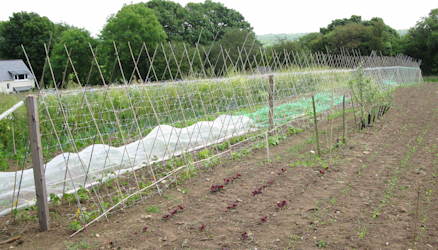 Pea multiplication, and bean trials, June 2012 |
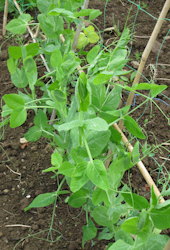 Magnum Bonum pea |
Magnum Bonum is a tall climbing pea, reaching up to about 6' if you give it the space and good soil. It has white flowers, and produces lots of peas. Its real stand-out quality, though, is taste. The big peas taste great cooked, but if you're like us you'll almost certainly find that you end up eating nearly all of them raw. They're not quite as sweet as some modern varieties, but have a really distinctive 'pea' flavour that we think makes them well worth growing. It will take a couple of years for us to bulk the seed up to the point where we have enough to sell, so watch out for them in around 2014 - 2015.
New soup peas
As well as table peas, we've also been trying out a number of soup peas over the years. They're only really for those with plenty of space, but if you have a large garden or allotment, and want to try growing some of your own staple foods, soup peas are really worth considering, and are certainly easier than dried beans in wetter/cooler parts of the country.
This spring, we were given a big pot of Boddington's Soup pea by a neighbour, which are very popular with local gardeners up and down the valley. We've not been able to find any more information about this variety, but they've found them very productive and tasty, so we've included them as a trial to see how they compare to the Latvian soup pea which is our favourite soup pea so far.
French bean trials
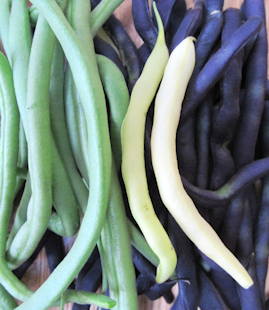 We've also been looking at our selection of french beans over the last couple of years, and have some more trials going on this year. For our own use - and for you - we're looking for beans that are early, set well, and taste good. Ideally we like a range of different colours and pod shapes.
We've also been looking at our selection of french beans over the last couple of years, and have some more trials going on this year. For our own use - and for you - we're looking for beans that are early, set well, and taste good. Ideally we like a range of different colours and pod shapes.
We love our Cosse Violette (aka Purple Podded) climbing bean which we've offered for a few years now. Although purple podded beans lose their colour on cooking, they help make the garden look good, and they're also much easier to find when you're picking. But we also like yellow / gold podded beans which do keep their colour and look very pretty if you cook a mix of green/yellow pods together.
At the moment our favourite yellow podded bean is the Minidor bush bean, but we know that a lot of people prefer climbing varieties (much better if you have limited space, or slugs that like to eat your bean pods), so in this year's trials we're looking for a great yellow podded climber to add to our collection. We're also trialling various green varieties with different pod shapes, and comparing them against our current favourites.
Another much anticipated row on our big pea and bean frame is the Coco Sophie flat podded french bean. We offered this bean several years back and it was very popular, but then a combination of crop failure and germination problems meant that we ended up losing our stock seed.
This spring, Tony Ascough found some saved seed and sent us some. We're growing it now, and if it is definitely correct (and grows true to type) we may be able to offer it again in future years.
Runner bean trials
Our final new bean under trial for this year is a French runner grown for the dried beans. René's Mungils come from a smallholding farmer (called René, of course) in the Ariege, in France. They are interesting in that they are similar to our Czar - a UK variety - in that they are bred for dual use of both dried seed and fresh pods.
But they are definitely an old heirloom in that René , who is in his 60s, got them from him father and his family has saved their own seed of it for generations. There is a fair chance that it will do well here in the UK, because he is at a high altitude, and so has a short season, despite being in the south - so the beans have been selected over the years for setting quickly.
Winter squash trials
This spring, were excited to receive an email from Tom Hartley about a hardy squash that he's been growing in wet and windy conditions :
"My mum acquired some winter squash seed from a smallholder in Kazakhstan last year. I try every year to find vegetables which will crop well with absolutely no attention whatsoever - that's my kind of plant!" - Tom H |
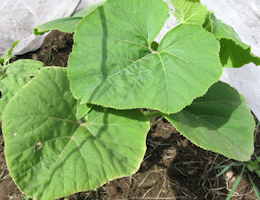 Tom's squash on our windy mountain field at 100m above sea-level |
Well, we too like un-fussy vegetables that just get on with it without lots of cosseting, so we definitely wanted to try this one. But our Early Golden Hubbard squash would cross with Tom's variety, so we decided we'd give the Kazakh squash a real 'do or die' test and put it in our new isolation garden up on our mountain fields.
We've given the plants a bit of protection as they get established with some hoops and mesh as a windbreak, but otherwise we've left them to get on with it, and will see how they fare. If all goes well we'll do a bigger trial on our main fields in future years. Tom's research suggests that the variety might be "Krupnoplodnaya 1", though he's not certain, and if they do prove worth continuing with, we'll be trying to track down more information about their background.
Serbian sweet pepper trials
 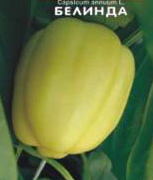 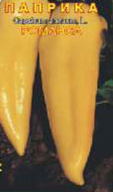 A few of our early Serbian Peppers under trial |
Our other big trial this year is a range of sweet peppers from Serbia. We got in touch with a nice Serbian seed company and after a bit of dodgily -translated email we did an exchange, giving them some of our best breeding lines in return for samples of their traditional early peppers. None of these varieties are (yet) available in the West, and we are growing them in our greenhouse to see how they do here. The best we will bulk up and you should see them in the catalogue in 2014 - but there may be a few 'sneak preview' packets available this autumn from the trial plants.
New Greens
For everyone who - like us - loves leafy greens and eats lots of them, we've got some good varieties coming along this year and next:
The East Friesian Palm kale comes from Ostfriesland in North Germany. Its a particularly hardy variety with very crinkled leaves and a good flavour. We've been growing it for a few years, but have only had a few packets of our spare breeding seed to set aside for sale. This year we've finally had the space to put in a big bed, so all being well - and rabbit fences continuing to hold - they should flower next summer, and we should have plenty of seed available from late 2013.
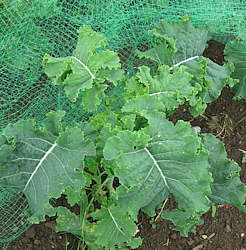 East Frieisian Palm Kale (netting to deter pigeons and cabbage whites) |
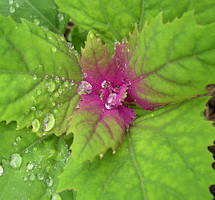 Magentaspreen, for salads |
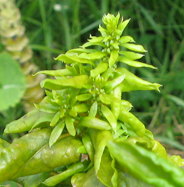 Golden chard in flower |
Pink Passion is a lovely chard variety with pink to red tinged stems from Frank and Karen Morten at Wild Garden Seeds. Unlike many veg, coloured stem chards keep their colour well when you cook them, so you get a very pretty dish of dark green leaves and cheerful pink stems. The baby leaves also go well in a salad, and look very attractive on the plate.
Magentaspreen giant goosefoot is likely to be new to many - if not most - gardeners. Its related to the quinoa and huauzontle that we've been growing for many years, but its generally used as a baby salad leaf, soft with a good flavour and pretty crimson markings to the leaves and stems. You can also grow it on and use the more mature leaves as a cooked green.
More space in a newly-expanded office
 Although we're trying not to grow Real Seeds - as we explained in last years' newsletter, we'd rather stay small and keep our standards up - it does seem as though we always have a little more seed than we quite have room for.
Although we're trying not to grow Real Seeds - as we explained in last years' newsletter, we'd rather stay small and keep our standards up - it does seem as though we always have a little more seed than we quite have room for.
We rent our office in town from the local council - it's in an old school that has been converted into several business units - and luckily an extra room next door to our current unit has come free - so we've been able to take that on as well.
It will make it much better in the busy periods not being all so crammed in together.
Over the summer we're only in the office a couple of times a week (being busy growing things on the field), and often there's only two of us there at a time, so the current arrangement is fine. But in the winter, when we are sending out thousands of packets a day, there can be four of us in there and it's just a bit too crowded.
The idea is to move bulk unpacked seed into the new room, which will become our packing area, and keep the packeted seed in the original room where orders are made up. Ben is busily planning all sorts of racking, storage and shelving that will mean that hopefully will keep all our neatly packed seed organised and easy to find when you all start ordering madly in the autumn!
New Office technology
An enormous project this year has been to completely rewrite the database that keeps track of all the seeds and orders. It's not exciting though, so we won't talk about it other than to say it has taken hundreds of hours and needed to be done. The idea is to have a much more user-friendly system so that Catherine and Felicia can do more of the admin work, freeing Ben & Kate up the extra growing time that they'll need when the two new polytunnels are up and running
 Much more fun was inventing a machine to feed 1000 seed envelopes at a time into the printer - we ended up with what can only be described as 'the thing'.
Much more fun was inventing a machine to feed 1000 seed envelopes at a time into the printer - we ended up with what can only be described as 'the thing'.
It is made from a very eclectic set of materials - some kitchen cabinets, an antique gateleg table, 7 metres of heavy chain, some electrical trunking, some solar-panel mounting rack, 3 plastic chopping boards, wood from an Ash tree at our previous farm, and (last but not least) 3/4 of a brand-new high-speed inkjet printer (the missing 1/4 was cut off and thrown away) . It actually works very well, to everyone's surprise.
We also designed another really successful machine to sort good fat seeds from smaller thinner ones. 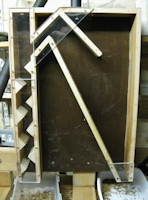 Technically speaking this is a 'vertical column zigzag aspiration density separator' but we just call it "the cleaning machine".
Technically speaking this is a 'vertical column zigzag aspiration density separator' but we just call it "the cleaning machine".
The design has been released ( the plans are here ) for anyone to use for non-profit purposes under a creative commons licence, and we've received emails from several people all over world who are building their own version.
The latest we heard of is a local parrot sanctuary (no, we didn't know there were such things either) who are using it to clean uneaten seed from empty husks.
For us, it will really help keep our quality up by ensuring that we only send out the biggest fattest seed in each lot, as these will germinate faster and get going more quickly.
And some Not-So-New things in the gardens this year!
Last year we introduced a new breadseed poppy, and thought that we had grown far too much seed - many years' worth - of what we expected to be a interesting but very minor addition to our range. To our astonishment, it appears that above all else, what you have all been waiting for all your lives is breadseed poppy seed - we swiftly ran out of seed, and had to pack all of our 'surplus' as well, and even that has now all gone except the last 12 packets. So, we have planted a much bigger bed of Sokol poppy this year - and hopefully we'll have enough this time!
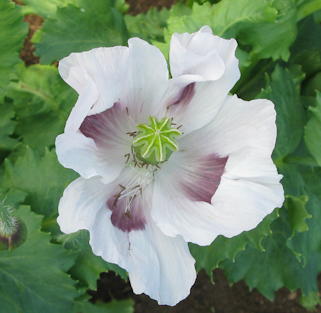 Sokol breadseed poppy |
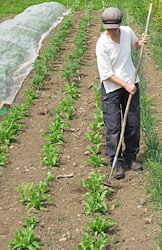 Kate weeding the new poppies, June 2012 |
Lots of people are starting to grow more vegetables as a way to deal with rising food prices and insecurity. We'd definitely support anyone who wants to grow their own food - but you definitely need to think carefully before starting, to make sure that you don't end up spending lots of money on seeds & sundries without seeing much return. We've got a few hints and tips for a 'credit crunch veg plot' lower down.
. . . but not for the zombie apocalypse
 The other thing that we continue to see is people who come to us worried about social breakdown and who want to buy large amounts of seed to store 'for an emergency'. But, wait - this really doesn't make sense! There are lots of websites out there selling 'survival seed packs' but they are just preying on people's fears and its really not a good use of your money.
The other thing that we continue to see is people who come to us worried about social breakdown and who want to buy large amounts of seed to store 'for an emergency'. But, wait - this really doesn't make sense! There are lots of websites out there selling 'survival seed packs' but they are just preying on people's fears and its really not a good use of your money.
Firstly, seeds are best sown fresh. Even stored in a fridge or freezer, the germination percentage and vigour will reduce over time, often quite quickly.
More importantly, suppose you do find you're in a nightmare situation where you suddenly need to grow your own food - it will be too late to start learning then! Even as an experienced gardener it can take several years to clear a new plot and make it properly productive.
And its not just learning to grow the food, you'll need to learn to save the seed, and store the veg overwinter. All take several years experience. So if tempted by one of these 'survival packs', just picture yourself hungry, standing there in front of your powerless defrosting freezer , with your now-out-of-date seeds in your hand. How exactly does that help you?
So, our view is this: Yes, we are living through the biggest theft in history - as the richest 1% of society turn gambling losses of private banks into public debt to be repaid by the rest of us, the taxpayers. Yes, it is outrageously unfair that our schools and hospitals are closed and privatised so that more money can be given to the bankers. And yes, coupled with climate change and peak oil, the current food supply and economic situation is pretty precarious. So, yes, we agree that it might well be wise to be a bit concerned at this point.
But if you are worried about the future, just stashing seeds away really won't help you. The best thing to do is to start your garden now, while you have spare time and money - and start learning now to grow veg well on your plot, maybe try to learn about storing it without electricity overwinter, and - even better - learn how to save your own seeds for future years. Perhaps your new skills won't ever be needed, but even so, you'll have had fun learning, and not lost anything.
There's lots of information on how to do this on our website here, plus we also sell (at a reduced price) Sue Stickland's book Back Garden Seedsaving, which will tell you all you could ever need to know about seedsaving.
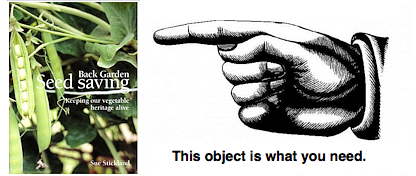
Planting your 'credit crunch plot'
Its also - providing you go about it with a bit of care - possible to save quite a bit of money by growing your own veg, and your food will be much nicer, fresher and tastier than food you can buy.
The best place to start if you're looking to save money by growing vegetables is to ask yourself the following questions:
What vegetables do you like to eat?
There's little point growing lots of courgettes if you or your children hate them, or potatoes if you always eat pasta. (Then again if pasta gets expensive, maybe you should learn to like potatoes more!) If you're growing something you love, you'll give it that little bit more care and attention and that will mean you get the best possible crop.
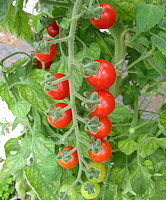 Cherry tomatoes make ideal snacks for children |
Which veg are expensive to buy in the shops?
Salad bags are expensive, yet salad leaves are easy to grow anywhere, even in a pot on a balcony. Mangetout peas also cost a lot to buy, but will crop well - and taste great straight from the plant.
If you're an absolute beginner gardener, a pot of salads and herbs in a sunny spot outside the kitchen door is definitely a good place to start.
What gives the best return for the space used?
Leafy greens like kale and chard/leaf beet are fantastic for this - you sow them in spring or summer one year, and they can crop right through to the following spring.
Courgettes and french/runner beans will crop all summer, while at the other extreme catch crops like radishes can take up space that would otherwise be empty for a few weeks when you have a gap.
How can you make sure that you have veg to eat outside of the summer 'glut' season?
A common mistake for beginners is to have a garden full of food in July and August, then suddenly find there's nothing to harvest once they get to autumn. Traditional winter crops like leeks, broccoli and cabbages are well worth growing if you have a reasonable sized garden, but take up space for a long time as they need to be sown in spring and grow right through the summer.
Think about trying some of the newer crops like the Oriental greens, which can be sown in late summer /early autumn to grow on into winter and have a look at our Summer Sowing guide for other ideas.
Scrounge, recycle and do-it-yourself
 Our comfrey bed may be a little bigger than yours . . . |
Its really easy to go to the garden centre and spend lots of money on compost, plant food, pots and tools - and come back having spent more money than you're ever likely to save on the vegetables you grow. But with a bit of inventiveness, most things that you need can be found or made for free.
Just for starters, think about recycling milk cartons and other containers into pots for seedlings (making a few holes in the bottom), collect nettles or grow comfrey to make your own liquid plant feed, and gather leaves in autumn to make leaf mould for your own seed & potting compost.
And do get yourself a good book (or borrow it from the library)
If you're looking for a good book to get you started, we really recommend Joy Larkcom's book Grow your Own Vegetables which is clear, simple and covers everything you could possibly need to know.
The final thing to beware of is over-enthusiasm! If you're a new gardener, its much better to start small and have a manageable number of plants that you can look after really well, rather than a huge patch that gets overwhelmed by weeds.
Our advice to beginners is that if you're thinking of spending more than £15 - £20 on seeds for your first season, then you're probably going to have far too many seeds!
Interesting Books
Every year we include a quick round-up of books old and new that we've come across through the year which may be of interest to other gardeners.
Following last year's newsletter, where we mentioned the books that we use when we're preserving any surplus veg, Mrs D Pratt wrote to us to say:
". . . there is now an even better “preserving” book: Putting Food By, authors Janet Greene, Ruth Hertzberg, Beatrice Vaughan. Yes, it is American but it is also really really comprehensive and ACCURATE." |
Having bought ourselves a copy, we would definitely agree that anyone wanting to preserve, store or freeze their surplus vegetables in quantity would find it very helpful.
Our feeling is that it's perhaps not the ideal book for a beginner, as there's so much detail it could be a little overwhelming - we'd still recommend 'Home Preservation of Fruit and Vegetables' originally published by the Ministry of Agriculture (see our books page) - but anyone wanting to build up serious stores could really do with having both books on their shelves.
Keep sowing through the summer!
Our annual reminder to gardeners - to avoid getting a huge glut in summer, and then nothing to eat later in winter, it is important to spread out your sowing over the year.
To help you plan your garden over the summer, we have a summer sowing guide, and also a less detailed month by month sowing guide that goes right through the year.
New Seed- Saving technique for chillies and peppers.
Teaching how to save seed at home is an important part of our work, and we've now sent out 65,000 sets of instructions for this. It's great to hear back from so many of you who are keeping your own seed now.
If you haven't tried it yet, do have a go. You just need to read our leaflets to be sure that the varieties dont cross, and do check out the instructions for drying your seed properly. If you just air-dry it it will suffocate when you put it in a sealed container.
One thing that always causes questions are peppers and chillies. People usually grow several different sorts, but they all cross like mad, so if you want to keep your own seed, this is a problem. You don't want giant chillies or sweet peppers the size of a pea the next year!
We now have a new method to show you , that lets you keep pure seed even if you are growing several types of pepper/chilli in the same greenhouse.
You will need:
- some sandwich-bag twist-ties
- an old pair of tights
- a sewing machine
- scissors
- tiny clothes-pegs, used for craft and 'scrapbooking' (look on ebay, about £2 for 100)
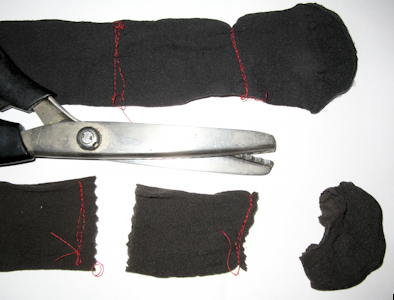 Sew across the tights and cut apart to make small insect-proof bags. |
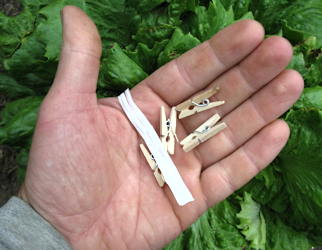 gather your tiny clothes-pegs and twist-ties |
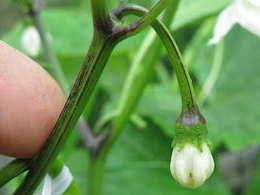 Now choose the best plant , and find a pepper flower that is going to open the next day . |
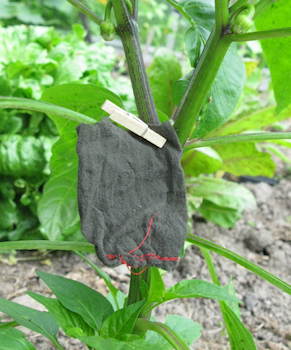 put the flower in the bag and peg it closed so no insects can get in |
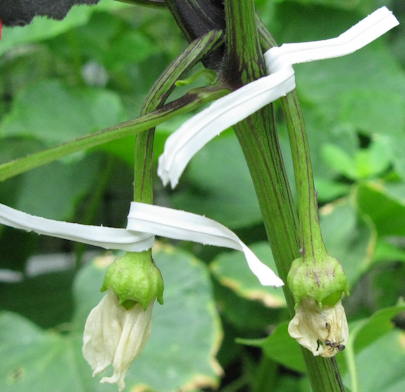 Once the flower has set (5 days or so) remove the bag and label it with a twist-tie. Not too tight, the stem will swell as it grows. |
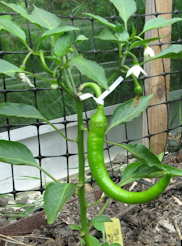 The marked fruit is the one to keep seed from - it will not have crossed with the others as no insects could get to the flower. |
Remember, this is really easy BUT it only works because you are using Real Seed. You can't keep seed from F1 Hybrids! (Which is why we don't sell them) |
|
Children's Gardening
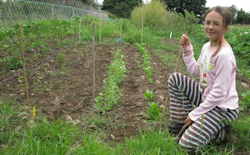 Our daughter Josie (who is now 10) thinks we should have a 'children's gardening' page on the website, and she's going to write it this summer. She says:
Our daughter Josie (who is now 10) thinks we should have a 'children's gardening' page on the website, and she's going to write it this summer. She says:
"I think that gardening is fun and that there are lots of easy and fun things to grow. I enjoy growing and popping exploding cucumbers because popping them makes me and my friends laugh. I have my own garden on the field and will mention some of the things I grow in the children's gardening page."
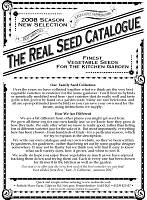 That's it for this year... until the new catalogue:
That's it for this year... until the new catalogue:
The new 2013 catalogue will come out in late October/early November - there are some really great new varieties in it, and we hope you'll enjoy it.
You'll get a copy automatically if you bought seed by post in the past year, and if you ordered over the internet you'll get an email letting you know when its available. So just to be clear:
If you ordered seed by post: You'll get posted a paper catalogue automatically and you do NOT need to request one. |
If you ordered seed online: You'll just get an email telling you the new catalogue is online. If you want a paper copy, you'll have to request one from the website. |
We hope you have a really good gardening year and that you manage to save some of your own seed at home, and perhaps even start breeding your own varieties.
Ben, Kate & Catherine, June 2012
(If you've enjoyed this newsletter and you're new to Real Seeds, you might like to have a look back at our earlier newsletters which have lots of articles and some nice recipes in them too.)
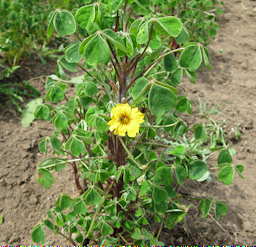 Oca in flower, June 2012 |
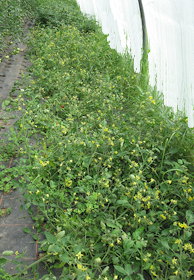 Large bed of Latah tomato for seed at Ian's farm, July 2012 |






